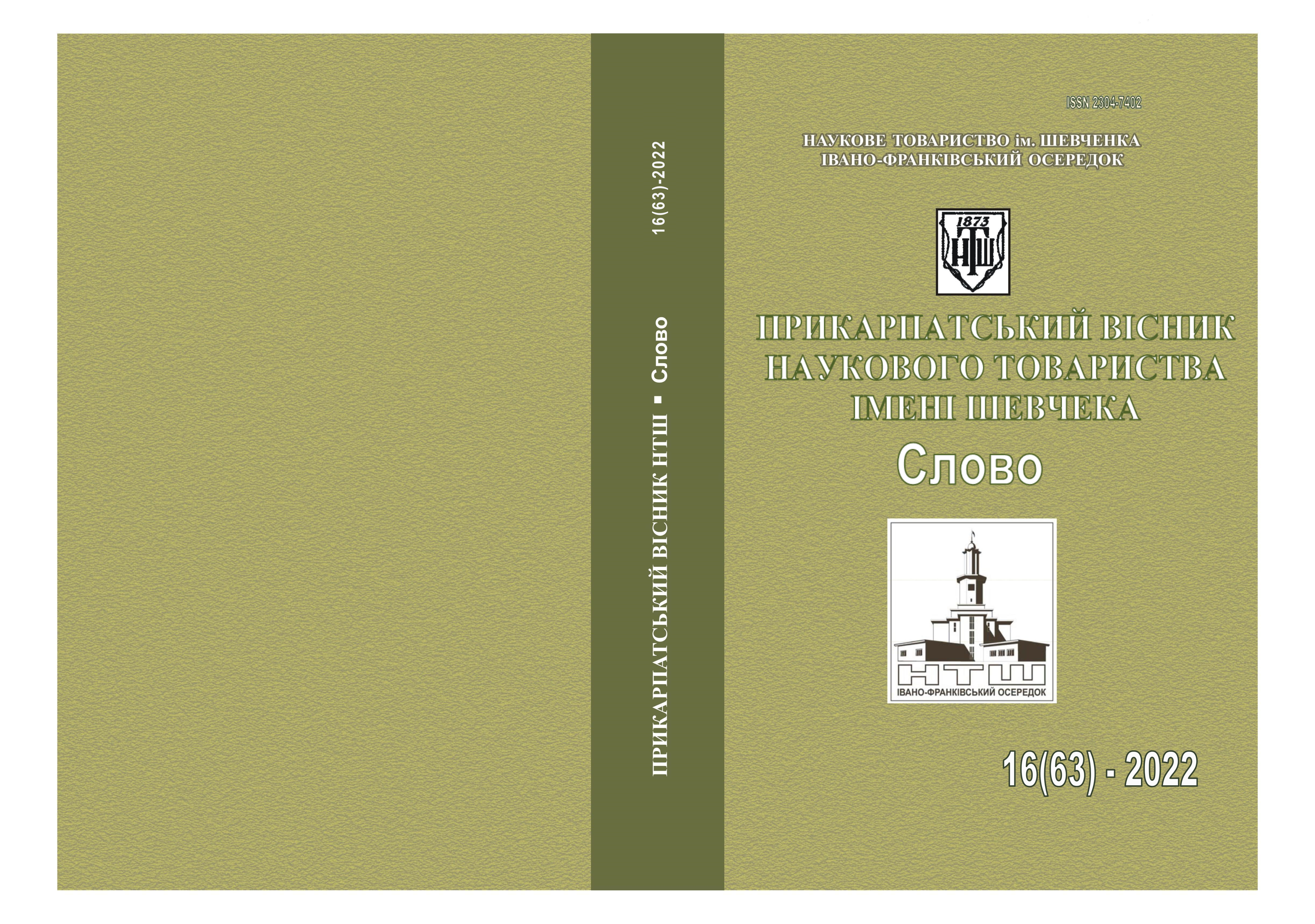«THT ABSOLUTE MISTER OF FORM»: VASYL STEFANYK’S NOVELLAS IN THE CONTEXT OF THE DEVELOPMENT OF THE UKRAINIAN PROSE AT THE END OF THE ХІХ TH – BEGINNING OF THE ХХ TH CENTURIES
DOI:
https://doi.org/10.31471/2304-7402-2022-16(63)-87-103Keywords:
literary generation, Ukrainian modernism, novella, story, image, sketch, psychograms, fragmentation, mood attunement, psychologism, polysemanticity, penetrating detail.Abstract
The article examines Vasyl Stefanyk’s novellas, stories, images, sketches, psychograms from his early collections «The Blue Booklet» (1899), «A Stone Cross» (1900), «The Road» (1901) and «My Word» (1905). It is observed that the peculiarity of the literary process at the turn of the ХІХth – ХХth centuries is close corresponding between the creative work of the representatives of several literary generations:the older one (I. Nechui-Levytskyi, Panas Myrnyi, A. Svydnytskyi, I. Karpenko-Karyi, I. Franko) and the younger one (M. Kotsiubynskyi, V. Stefanyk, O. Kobylianska, L. Martovych, Marko Cheremshyna, H. Khotkevych, B. Lepkyi and others). As a matter of fact, the opposition between the traditional and the groundbreaking often revealed itself through creative resistance between literary generations, created by the writers of approximately the same age (though not obligatorily), though close in their worldview and world feeling, fictional-aesthetic ideals, artistic tastes, not that often in aesthetic concepts and programmes, moreover, even in a psychic and spiritual organisation. It is elucidated that the short prose of the writers of the younger generation, i.e. those, who entered the literature in 1890s, witnesses an active renewal of literature, the authors’ searches of new ways and modes of modelling a fictional world.
The article observes that the creative work of the writers of the younger generation geenerates a specific force field of Ukrainian modernism with all its branches and currents (impressionism, expressionism, neo-romanticism, surrealism, symbolism, etc.). It seems that with many of its features modernism returns (at a different level of development) towards «old» romanticism, particularly through making a personality independent from social conditions of their existence, making an individual abstract from the general public, making this personality unusual and extraordinary, retreating from imitation and copying, employing the unreal and the mystical, etc.
In the work «From the last decades of the ХІХth century» Ivan Franko named Vasyl Stefanyk «the absolute mister of the form», «the true artist by God’s grace», who «does not take care of the reader’s attention», «does not use any rhetorical things in order to attract, to chain to himself». Laconism coupled with capacity and depth of the fictional detail, the tendency to the fragmentation of the plot, mood attunement, penetration into characters’ psychology, foremost, into the emotive sphere of their psyche ‒ those are the distinguishing features of the writer’s early works. It is noticed that Stefanyk frequently drew his heroes in borderline, even extreme situations, where they found themselves under certain circumstances. By the way, the extremum of their psycho-world is marked with the maximal tension, and not always can they cope with the frantic pulse of life. Stefanyk’s works are informatively rich, moreover, the intensity of information is hidden behind the polysemanticity of the word, the image, the detail, often a penetrating one. In the context of the development of Ukrainian short prose, Vasyl Stefanyk’s novellas distinguish themselves with laconism and expressiveness.
References
Легка О. Різдвяно-новорічне оповідання в українській прозі кінця ХІХ – початку ХХ ст. // Іван Денисюк: не попіл слів, а серця жар…: Зб. наук. праць та матеріалів. Львів, 2018. С. 91–101.
Літературознавча енциклопедія: У 2 томах / Автор-укладач Ю. Ковалів. К.: ВЦ «Академія», 2007. Т. 2. 624 с.
Мельник О. Модерністський феномен Михайла Яцкова: канон та інтерпретація. К.: Наук. думка, 2011. 295 с.
Микуш С. Вивчення поетики Василя Стефаника: навчальний посібник. Львів, 2011. 176 с.
Піхманець Р. Дивосвіт художнього слова Василя Стефаника [Післямова] // Стефаник В. Камінний хрест. Харків: Фоліо, 2013. С. 448–481.
Піхманець Р. Із покутської книги буття: Засади творчого мислення Василя Стефаника, Марка Черемшини і Леся Мартовича. К.: Темпора, 2012. 580 с.
Піхманець Р. Коментарі // Стефаник В. Камінний хрест. Харків: Фоліо, 2013. С. 482–520.
Стефаник В. Камінний хрест. Харків: Фоліо, 2013. 576 с. Покликаючись на це видання, в дужках вказуємо сторінку.
Стефаник В. Твори / За ред. Ю. Гаморака. Львів: Піраміда, 2015. 319 с. Покликаючись на це видання, в дужках вказуємо сторінку.
Франко І. Зібрання творів: У 50 т. К., 1976–1986. Покликаючись на це видання, в дужках вказуємо том і сторінку.
Яструбецька Г. Динаміка українського літературного експресіонізму: монографія. Луцьк: ПВД «Твердиня», 2013. 380 с.

